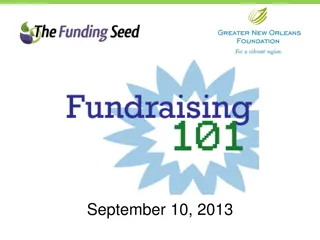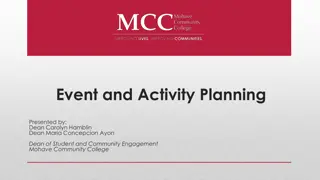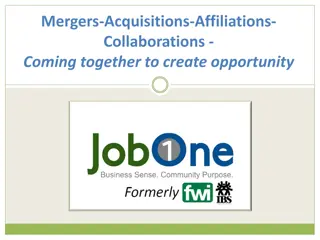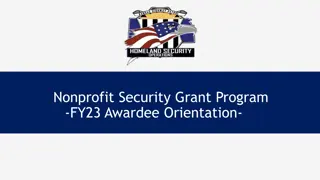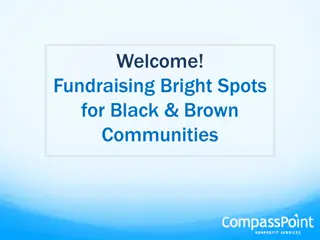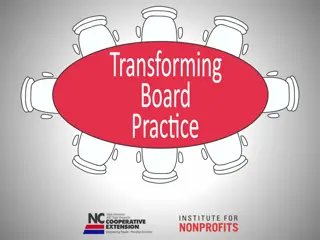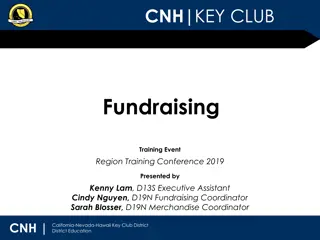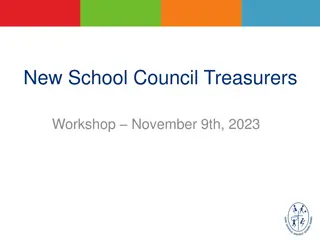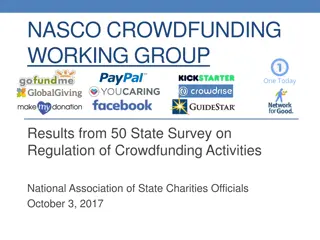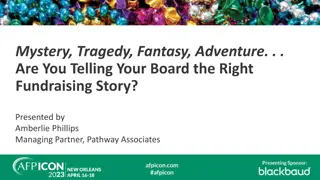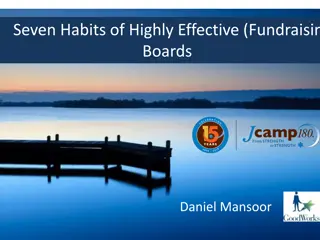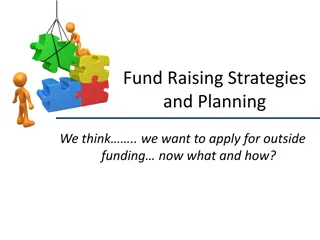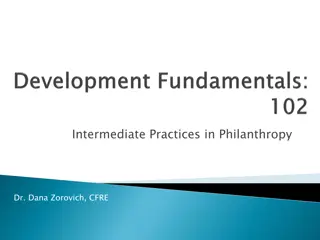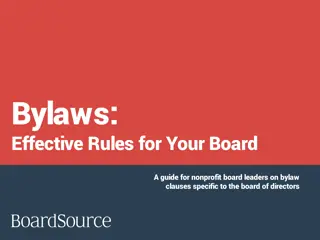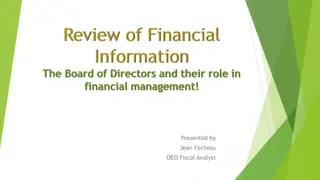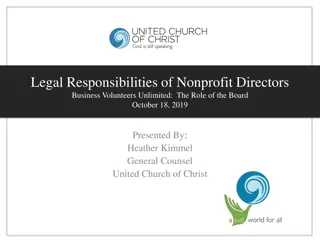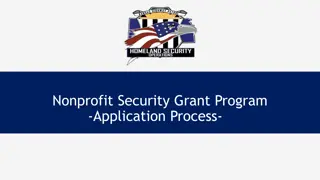
How To Develop A Successful Nonprofit Fundraising Strategy
A strong fundraising strategy not only helps raise funds but also enhances visibility, credibility, and sustainability for NGOs. By following these steps and continuously refining your approach, you can create a solid foundation for ongoing financial
Download Presentation

Please find below an Image/Link to download the presentation.
The content on the website is provided AS IS for your information and personal use only. It may not be sold, licensed, or shared on other websites without obtaining consent from the author. Download presentation by click this link. If you encounter any issues during the download, it is possible that the publisher has removed the file from their server.
E N D
Presentation Transcript
How To Develop A Successful Nonprofit Fundraising Strategy Welcome to the world of nonprofit fundraising, where passion meets purpose and generosity knows no bounds. As organizations dedicated to making a difference in the world, NGOs rely on effective fundraising strategies to fuel their missions and create lasting impact. In this blog post, we will delve into the essential steps needed to develop a successful nonprofit fundraising strategy that not only raises funds but also builds strong relationships with donors for long-term support. So grab your virtual pen and paper, and let's craft a strategy that will propel your NGO towards success! Understanding the Importance of a Fundraising Strategy Understanding the Importance of a Fundraising Strategy is crucial for nonprofit organizations striving to make a difference in their communities. A well-thought-out strategy serves as a roadmap that guides your fundraising efforts towards achieving specific goals and objectives. By having a clear plan in place, you can efficiently allocate resources, maximize donor engagement, and ultimately increase revenue to support your cause. Without a solid strategy in place, fundraising efforts can become scattered and ineffective, leading to missed opportunities and potential burnout among staff and volunteers. A strategic approach allows
you to focus on activities that yield the most significant impact while minimizing wasted time and resources on less fruitful endeavors. Moreover, a fundraising strategy provides direction and cohesion for your team, ensuring that everyone is aligned towards common objectives. It also helps build credibility with donors by demonstrating professionalism and accountability in how their contributions are utilized. In today's competitive landscape where donors have numerous options for charitable giving, having a well-defined fundraising strategy sets your organization apart by showcasing transparency, sustainability, and long-term vision. Identifying Your Organization's Goals and Mission Before diving into fundraising efforts, it is crucial for nonprofits to clearly define their goals and mission. Understanding the purpose of your organization will guide your fundraising strategy in a meaningful way. Take the time to reflect on what impact you want to make in the community and how you plan to achieve it. Whether it's providing educational resources, supporting healthcare initiatives, or advocating for social change, knowing your mission will help attract donors who align with your cause. Consider setting specific and realistic fundraising goals that are aligned with your organization's overall objectives. This will help create a focused approach when reaching out to potential donors and supporters. By identifying your organization's goals and mission from the outset, you can establish a strong foundation for successful fundraising campaigns that resonate with both existing and prospective donors alike. Researching Potential Donors and Target Audience Researching potential donors and target audience is a crucial step in developing a successful nonprofit fundraising strategy. By understanding who your potential donors are, you can tailor your approach to resonate with them on a deeper level. Start by looking at demographics, interests, and giving patterns to create donor profiles that guide your outreach efforts. Utilize data analytics tools to gather insights into donor behavior and preferences. This information will help you craft personalized messaging that speaks directly to their motivations for supporting your cause. Conduct surveys or focus groups to gain direct feedback from current donors and prospects about what resonates with them most. Explore social media platforms and online forums where your target audience engages. Engage with them authentically by sharing compelling stories about the impact of your organization's work.
Building relationships based on trust and shared values is key to cultivating long-term support from donors who believe in your mission. By investing time in researching potential donors and understanding your target audience, you set the foundation for building meaningful connections that drive impactful fundraising results for your nonprofit organization. Creating a Budget and Setting Realistic Goals When it comes to nonprofit fundraising, creating a budget and setting realistic goals is key. Start by assessing your organization's financial standing and determining how much you need to raise. Consider expenses such as staff salaries, marketing materials, and event costs. Next, outline specific fundraising goals that align with your mission. Whether it's raising a certain amount of money or increasing donor engagement, make sure your goals are measurable and achievable within a set timeframe. Once you have your budget and goals in place, prioritize fundraising tactics that will help you reach them. This could include hosting events, launching online campaigns, or reaching out to potential donors directly. Remember to regularly review your progress against the budget and goals you've set. Adjust strategies as needed to stay on track and maximize fundraising efforts effectively. By setting clear budgets and achievable goals, your nonprofit can better focus its resources towards making a meaningful impact in the community. Implementing Effective Fundraising Tactics Implementing effective fundraising tactics is crucial for the success of any nonprofit organization. One strategy to consider is diversifying your fundraising channels to reach a wider audience and maximize donations. This can include online campaigns, events, grant applications, and partnerships with businesses or other nonprofits. Utilizing social media platforms can also be a powerful tool in reaching potential donors and raising awareness about your cause. Engaging storytelling and compelling visuals can help convey the impact of your work and inspire people to support your mission. Another tactic to consider is creating targeted fundraising campaigns based on donor preferences or past giving history. Personalization can increase donor engagement and loyalty over time. Regularly analyzing data and metrics from previous fundraising efforts can provide valuable insights into what strategies are most effective for your organization. Testing new ideas and being willing to adapt based on results is key in continuously improving your fundraising tactics.
Measuring Success and Making Adjustments Measuring the success of your nonprofit fundraising efforts is crucial to understanding what is working and what needs adjustment. Tracking key metrics such as donation amounts, donor retention rates, and campaign ROI can provide valuable insights into the effectiveness of your strategies. By analyzing this data regularly, you can identify trends, strengths, and areas for improvement. This information allows you to make informed decisions about where to allocate resources and how to optimize future campaigns. In addition to measuring success, it's essential to be proactive in making adjustments based on your findings. Whether it's tweaking messaging, targeting a different audience segment, or trying out new fundraising tactics, being adaptable is key to staying relevant and impactful in the nonprofit sector. Remember that fundraising strategies are not set in stone; they should evolve with the changing landscape of donor behavior and market trends. Stay agile in your approach and be willing to pivot when necessary for continued success in achieving your NGO fundraising goals. Building Relationships with Donors for Long-Term Support To develop a successful nonprofit fundraising strategy, establishing and nurturing relationships with donors is crucial for long-term support. Building genuine connections goes beyond simply asking for donations; it's about cultivating meaningful partnerships based on trust and mutual goals. Donors want to feel valued and appreciated for their contributions, so personalized communication and regular updates on how their support makes an impact are key. Show them the tangible results of their donations through success stories, photos, or videos that highlight the difference they are making. Engage with donors on multiple platforms, whether through social media interactions, emails, phone calls, or in-person meetings. Acknowledge their generosity publicly by recognizing them at events or in your organization's publications. By fostering strong relationships built on transparency and gratitude, you can turn one-time contributors into loyal supporters who will champion your cause for years to come. Utilizing Technology for Fundraising Efforts In today's digital age, utilizing technology for fundraising efforts is essential for nonprofit organizations to reach a wider audience and increase donations. One effective way to leverage technology is by creating an engaging website that clearly communicates your mission and impact. Incorporate online donation portals to make it easy for supporters to contribute.
Social media platforms such as Facebook, Twitter, and Instagram provide valuable tools for spreading awareness about your cause. Engage with followers through compelling content, updates on projects, and success stories. Email marketing campaigns are another powerful tool in the digital fundraising arsenal. Segment your donor list based on interests and giving history to personalize messages and maximize engagement. Virtual events, crowdfunding platforms, and mobile fundraising apps are also innovative ways to connect with donors remotely and raise funds efficiently. By embracing technology in your fundraising strategy, you can amplify your organization's reach and impact in the nonprofit sector. Conclusion: The Importance As a nonprofit organization, developing a successful fundraising strategy is crucial for achieving your mission and goals. By understanding the importance of having a well-thought-out plan, identifying your target audience, setting realistic goals, implementing effective tactics, and utilizing technology, you can maximize your fundraising efforts. Remember that building relationships with donors is key to securing long-term support for your cause. Measure the success of your fundraising activities regularly and be prepared to make adjustments as needed. Embrace innovation and leverage technology to reach a wider audience and streamline your processes. A strong fundraising strategy not only helps raise funds but also enhances visibility, credibility, and sustainability for NGOs. By following these steps and continuously refining your approach, you can create a solid foundation for ongoing financial support that will enable you to make a lasting impact in the community. Visit- https://www.centreforfundraising.com/solution/fundraising-strategy-planning

